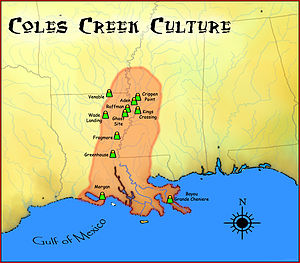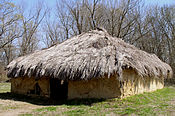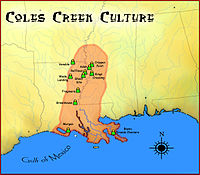- Coles Creek culture
-
Coles Creek culture is a Late Woodland archaeological culture in the Lower Mississippi valley in the southern United States. It followed the Troyville culture. The period marks a significant change in the cultural history of the area. Population increased dramatically and there is strong evidence of a growing cultural and political complexity, especially by the end of the Coles Creek sequence. Although many of the classic traits of chiefdom societies aren't yet manifested, by 1000 CE the formation of simple elite polities had begun. Coles Creek sites are found in Arkansas, Louisiana, and Mississippi. It is considered ancestral to the Plaquemine culture.
Contents
Features
The Coles Creek culture is an indigenous development of the Lower Mississippi Valley that took place between the terminal Woodland period and the later Plaquemine culture period. The period is marked by the increased use of flat-topped platform mounds arranged around central plazas, more complex political institutions, and a subsistence strategy still grounded in the Eastern Agricultural Complex and hunting rather than on the maize plant as would happen in the succeeding Plaquemine Mississippian period. The culture was originally defined by the unique decoration on grog-tempered ceramic ware by James A. Ford after his investigations at the Mazique Archeological Site. He had studied both the Mazique and Coles Creek Sites, and almost went with the Mazique culture, but decided on the less historically involved sites name.[1]
Chronology
Culture Lower Yazoo Basin Phases Dates Natchez Bluff Phases Dates Tensas Basin Phases Dates Barataria Bay Phases Dates Coles Creek Crippen Point 1050 to 1200 CE Gordon 1100-1200 CE Preston 1100-1200 CE St. Gabriel 1000-1200 CE Kings Crossing 900 to 1050 CE Balmoral 1000-1100 CE Balmoral 1000-1100 CE Aden 800 to 900 CE Ballina Bayou Cutler 875-1000 CE Bayland 700 to 800 CE Sundown Bayou Ramos 700-875 CE Architecture
Although earlier cultures built mounds mainly as a part of mortuary customs, by the Coles Creek period these mounds took on a newer shape and function. Instead of being primarily for burial, mounds were constructed to support temples and other civic structures. Pyramidal mounds with flat tops and ramps were constructed, usually over successive years and with many layers. A temple or other structures, usually of wattle and daub construction, would be built on the summit of the mound. A typical Coles Creek site plan consisted of at least two and more commonly three, mounds around a central plaza. This pattern emerged in roughly 800 CE and continued for several hundred years. By late Coles Creek times, the site plans are often enlarged to include up to three more mounds. Sites typical of this period are Mount Nebo, Holly Bluff, Kings Crossing, and Lake Agnes. Many Coles Creek mounds were erected over earlier mortuary mounds, leading researchers to speculate that emerging elites were symbolically and physically appropriating dead ancestors to emphasize and project their own authority. [5]
Material Culture
Long distance trade seems to have been negligible at this time, as exotic goods and trade items are rare in Coles Creek sites. There is little evidence of domesticated or cultivated plants until the end of the Coles Creek period. Acorns are a dominant food source, supplemented with persimmons, palmetto, and some starchy seeds such as maygrass. Coles Creek populations may have loosely "managed" certain plant resources in order to promote a better or more consistent food supply. Maize is found in very limited quantities, but by 1000-1200 CE had begun to increase, although nowhere near the levels it would reach in later Mississippian times. The bow and arrow was introduced in this period, although the atlatl continued to be used. Pottery styles changed during this period, as people began to create more durable wares with more diversified uses. Wet clay was tempered with particles of dry clay to prevent cracking during firing. Most pots were decorated only on the upper half, usually with designs of incised lines or impressed tool marks. Colors ranged from tan, black, brown and gray, although the rare red example is known. Also, the rare effigy pot is found. [6]
Known Coles Creek culture sites
Site Image Description Aden Site Located in Issaquena County, Mississipp, it is the type site for the Aden Phase (800-900 CE) of the Lower Yazoo Basin Coles Creek chronology. Balmoral Mounds A group of three mounds located in Tensas Parish, Louisiana.[7] Type site for the Balmoral Phase(1000-1100 CE) of the Tensas Basin and Natchez Bluffs Coles Creek chronology Bayou Grande Cheniere Mounds 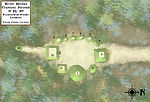
A large group of twelve mounds located in Plaquemines Parish, Louisiana from the Coastal Coles Creek culture.[4] Crippen Point site Type site for the Crippen Point Phase(1050-1200 CE) of the Lower Yazoo Basin Coles Creek chronology, located in Sharkey County, Mississippi. Cypress Grove Mound A well preserved conical mound located in Concordia Parish, Louisiana dating from approximately 750 CE.[8] DePrato Mounds A multimound complex located in Concordia Parish, Louisiana, radiocarbon and decorated pottery dated to about 600 CE during the Troyville/Coles Creek period.[9] Filhiol Mound Site Located in Ouachita Parish, Louisiana on a natural levee of the Ouachita River[10] Flowery Mound A single mound Late Coles Creek to Plaquemine/Mississippian site in Tensas Parish, Louisiana which dates from approximately 950–1541.[11] Frogmore Mound Site 
A Late Coles Creek site in Concordia Parish, Louisiana.[12] Ghost Site Mounds A site in Tensas Parish, Louisiana with an Early to Middle Coles Creek component(700–1200)and a Late Coles Creek to Plaquemine component(1200 to 1541)[13] Greenhouse Site A multimound site in Avoyelles Parish, Louisiana from the Troyville-Coles Creek Period[14] Insley Mounds A multimound site in Richland Parish, Louisiana with a Poverty Point period component (1700–1000 BCE) and a Coles Creek component (720 to 1200 CE).[15] Kings Crossing Site 
The type site for the Kings Crossing phase (900 -1050 CE), a multimound site located near Vicksburg in Warren County, Mississippi[16] Lamarque Landing Mound A single mound site in Concordia Parish, Louisiana dating to about 1000 CE.[17] Marsden Mounds A multimound site in West Carroll Parish, Louisiana near Delhi, Louisiana, with a Poverty Point period component (1500 BCE) and a Coles Creek component (400 to 1200 CE).[18] Mazique Archeological Site 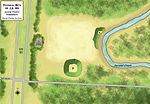
A multimound site in Adams County, Mississippi southeast of Natchez, Mississippi, with components from both the Coles Creek period (700-1000 CE) and the later Plaquemine Mississippian period (1000-1680 CE), when it was recorded in historic times as the White Apple village of the Natchez people.[1] Mott Mounds 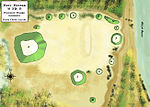
A large multimound site with components from the Late Marksville to the Plaquemine period but with its main occupation during the Coles Creek period, located in Franklin Parish, Louisiana.[19] Peck Mounds 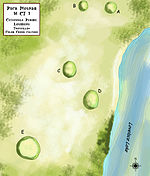
A multimound site from the Late Troyville-Early Coles Creek period located in Catahoula Parish, Louisiana[20] Raffman Site 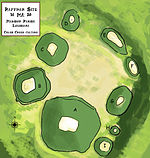
A multimound site whose main period of occupation was during the Balmoral Phase(1000-1100 CE) of the Tensas Basin and Natchez Bluffs Coles Creek chronology, located in Madison Parish, Louisiana and constructed between 700 and 1000 CE[21] Scott Place Mounds A multimound site from the Late Coles Creek-Early Plaquemine period located in Union Parish, Louisiana[22] Sundown Mounds A multimound site from the Early Coles Creek in Tensas Parish, Louisiana that is the type site for the Sundown Phase(700-800 CE)[23] Transylvania Mounds A large multimound site with 2 plazas and components from the Coles Creek (700–1200) and Plaquemine/Mississippian periods (1200–1541). It located in East Carroll Parish, Louisiana[24] It is the type site for the Translyvania Phase of the Tensas Basin Plaquemine Mississippian chronology. Troyville Earthworks 
A large multimound site with components dating from 100 BCE to 700 CE. It once had the tallest mound in Louisiana at 82 feet (25 m) in height. It is located in Catahoula Parish, Louisiana in the town of Jonesville.[24] Venable Mound A single mound site with components from the Troyville, Coles Creek and Plaquemine periods, located in Morehouse Parish, Louisiana[25] Wade Landing Mound A single mound site located in Caldwell Parish, Louisiana[26] See also
- Plum Bayou culture
- Culture, phase, and chronological table for the Mississippi Valley
References
- ^ a b Daniel A. LaDu (2009). An exploration of the age of mound construction at Mazique (22AD502), a Late Prehistoric mound center in Adams County, Mississippi (Thesis). Tuscaloosa, Alabama: Department of Anthropology, University of Alabama. http://acumen.lib.ua.edu/content/u0015/0000001/0000151/u0015_0000001_0000151.pdf. Retrieved 2011-10-31.
- ^ Virgil Roy Beasley III (2007). "Feasting on the Bluffs : Anna Site Excavations in the Natchez Bluffs of Mississippi". In Rees, Mark A.; Livingood, Patrick C.. Plaquemine Archaeology. University of Alabama Press. p. 135.
- ^ Phillips, Philip (1970). Archaeological Survey In The Lower Yazoo Basin, Mississippi, 1945-1955. Peabody Museum, Harvard University.
- ^ a b Timothy M. Schilling (May 2004). Excavations at the Bayou Grande Cheniere Mounds (16PL159) : A Coles Creek Period Mound Complex (Master of Arts thesis). Louisiana State University and Agricultural and Mechanical College. http://etd.lsu.edu/docs/available/etd-04132004-152641/unrestricted/Schilling_thesis.pdf. Retrieved 2011-10-31.
- ^ Kidder, Tristram (1998). Lewis, R. Barry; Stout, Charles. eds. Mississippian Towns and Sacred Spaces. University of Alabama Press. ISBN 0-8173-0947-0.
- ^ "Troyville-Coles Creek". Louisiana prehistory. 2010-07-01. http://www.crt.state.la.us/archaeology/virtualbooks/LAPREHIS/marca.htm.
- ^ "Indian Mounds of Northeast Louisiana:Balmoral Mounda". http://www.crt.state.la.us/archaeology/moundsguide/balmoral.html. Retrieved 2011-10-20.
- ^ "Indian Mounds of Northeast Louisiana : Cypress Grove Mound". http://www.crt.state.la.us/archaeology/moundsguide/CypressGrove.html. Retrieved 2011-10-20.
- ^ "Indian Mounds of Northeast Louisiana : Deprato Mounds". http://www.crt.state.la.us/archaeology/moundsguide/DePratoMounds.html. Retrieved 2011-10-21.
- ^ "Indian Mounds of Northeast Louisiana:Filhiol Mound". http://www.crt.state.la.us/archaeology/moundsguide/filhiol.html. Retrieved 2011-10-20.
- ^ "Indian Mounds of Northeast Louisiana : Flowery Mound". http://www.crt.state.la.us/archaeology/moundsguide/flowery.html. Retrieved 2011-10-220.
- ^ "Indian Mounds of Northeast Louisiana:Frogmore Mound". http://www.crt.state.la.us/archaeology/moundsguide/Frogmore.html. Retrieved 2011-10-17.
- ^ "Indian Mounds of Northeast Louisiana:Ghost Site Mounds". http://www.crt.state.la.us/archaeology/moundsguide/ghostsite.html. Retrieved 2011-10-20.
- ^ "Louisiana Prehistory:Marksville, Troyville-Coles Creek, and Caddo". http://www.crt.state.la.us/archaeology/virtualbooks/LAPREHIS/marca.htm. Retrieved 2011-10-20.
- ^ "Indian Mounds of Northeast Louisiana:Insley Mounds". http://www.crt.state.la.us/archaeology/moundsguide/insley.html. Retrieved 2011-10-20.
- ^ Phillips, Philip (1970). "Archaeological Survey in the Lower Yazoo Basin, Mississippi, 1949-1955". Peabody Museum. pp. 435.
- ^ "Indian Mounds of Northeast Louisiana : Lamarque Mounds". http://www.crt.state.la.us/archaeology/moundsguide/LamarqueLanding.html. Retrieved 2011-10-20.
- ^ "Indian Mounds of Northeast Louisiana:Marsden Mounds". http://www.crt.state.la.us/archaeology/moundsguide/marsden.html. Retrieved 2011-10-20.
- ^ Schilling, Timothy (Winter 2006-2007), "Archaeology at the Mott Mounds", Newsletter of the Louisiana Archaeological Society, 34 (3 ed.), Louisiana Archaeological Society, pp. 8-12, http://www.laarchaeology.org/files/newsletter343.pdf
- ^ "Indian Mounds of Northeast Louisiana:Peck Mounds". http://www.crt.state.la.us/archaeology/moundsguide/Peck.html. Retrieved 2011-10-20.
- ^ Tristam R. Kidder. "Plazas as architecture : An example from the Raffman Site, Northeast Louisiana". http://www.jstor.org/pss/4128404. Retrieved 2011-10-21.
- ^ "Indian Mounds of Northeast Louisiana:Scott Place Mounds". http://www.crt.state.la.us/archaeology/moundsguide/scottplace.html. Retrieved 2011-10-20.
- ^ "Indian Mounds of Northeast Louisiana:Sundown Mounds". http://www.crt.state.la.us/archaeology/moundsguide/sundown.html. Retrieved 2011-10-21.
- ^ a b "Indian Mounds of Northeast Louisiana:Translyvania Mounds". http://www.crt.state.la.us/archaeology/moundsguide/transylvania.html. Retrieved 2011-10-20.
- ^ "Indian Mounds of Northeast Louisiana:Venable Mound". http://www.crt.state.la.us/archaeology/moundsguide/venable.html. Retrieved 2011-10-20.
- ^ "Indian Mounds of Northeast Louisiana:Wade Landing Mound". http://www.crt.state.la.us/archaeology/moundsguide/wadelanding.html. Retrieved 2011-10-20.
- Hudson, Charles M., Knights of Spain, Warriors of the Sun: Hernando De Soto and the South's Ancient Chiefdoms, University of Georgia Press, 1997. ISBN 0-8203-1888-4
- R. Barry Lewis and Charles Stout, editors., "Mississippian Towns and Sacred Spaces", University of Alabama Press, 1998. ISBN 0-8173-0947-0
External links
 Coles Creek and Plum Bayou cultures
Coles Creek and Plum Bayou culturesLate Woodland period · List of archaeological periods (North America) Coles Creek sites Aden Site · Balmoral Mounds · Churupa Plantation Mound · Coles Creek Site · Crippen Point site · Cypress Grove Mound · DePrato Mounds · Greenhouse Site · Filhiol Mound Site · Fisher Site · Flowery Mound · Frogmore Mound Site · Ghost Site Mounds · Greenhouse Site · Insley Mounds · Kings Crossing Site · Lamarque Landing Mound · Marsden Mounds · Mazique Archeological Site · Mott Mounds · Mound Plantation · Peck Mounds · Raffman Site · Scott Place Mounds · Shackleford Church Mounds · Sundown Mounds · Transylvania Mounds · Troyville Earthworks · Venable Mound · Wade Landing Mound ·Coastal Coles Creek sites Atchafalaya Basin Mounds (16SMY10) · Bayou Black Mound (16TR78) · Bayou Cypremont (16SMY7) · Bayou Grande Cheniere Mounds · Bayou L’Ours Site · Bayou Portage Mounds · Bayou Sorrel Mounds (16IV4) · Clovelly Site (16LF64) · Cypress Point Site (16VM112) · Eagle Point Site (16IB123) · Gibson Mounds (16TR5) · Greenwood Cemetery Site (16SMY10) · Kleinpeter Mounds · Little Cheniere Site (16CM22) · Little Pecan Island Site (16CM43) · Jerry Haas Site (16SJ51) · Machias Lake (16SB2) · Morgan Mounds (16VM9) · Pecan Mounds (16SM37) · Pennison Mounds (16AS16) · Portage Mounds (16SM5) · Richeau Field Site (16TR82) · Schwing Place Mound (16IV13) · Southwest of Cut Off Lagoon (16SB50) · St. Gabriel Mounds (16IV128) · Temple Mounds Site (16LF4) ·Plum Bayou sites Chandler Landing Site · Coy Site (3LN20) · Dogtown Site · Hayes Site (35CS196) · Maberry Site · Roland Site (3AR30) · Toltec Mounds ·Related topics · Eastern Agricultural Complex · Fourche Maline culture · Mississippian culture · Natchez · Plaquemine culture · Platform mound · Taensa · Troyville culture · Categories:- Coles Creek culture
- Woodland period of North America
- Archaeological cultures of North America
- Native American history of Mississippi
- Native American history of Louisiana
- Native American history of Arkansas
- Native American history of Oklahoma
- Native American history of Texas
- Archaeological sites in Mississippi
Wikimedia Foundation. 2010.

